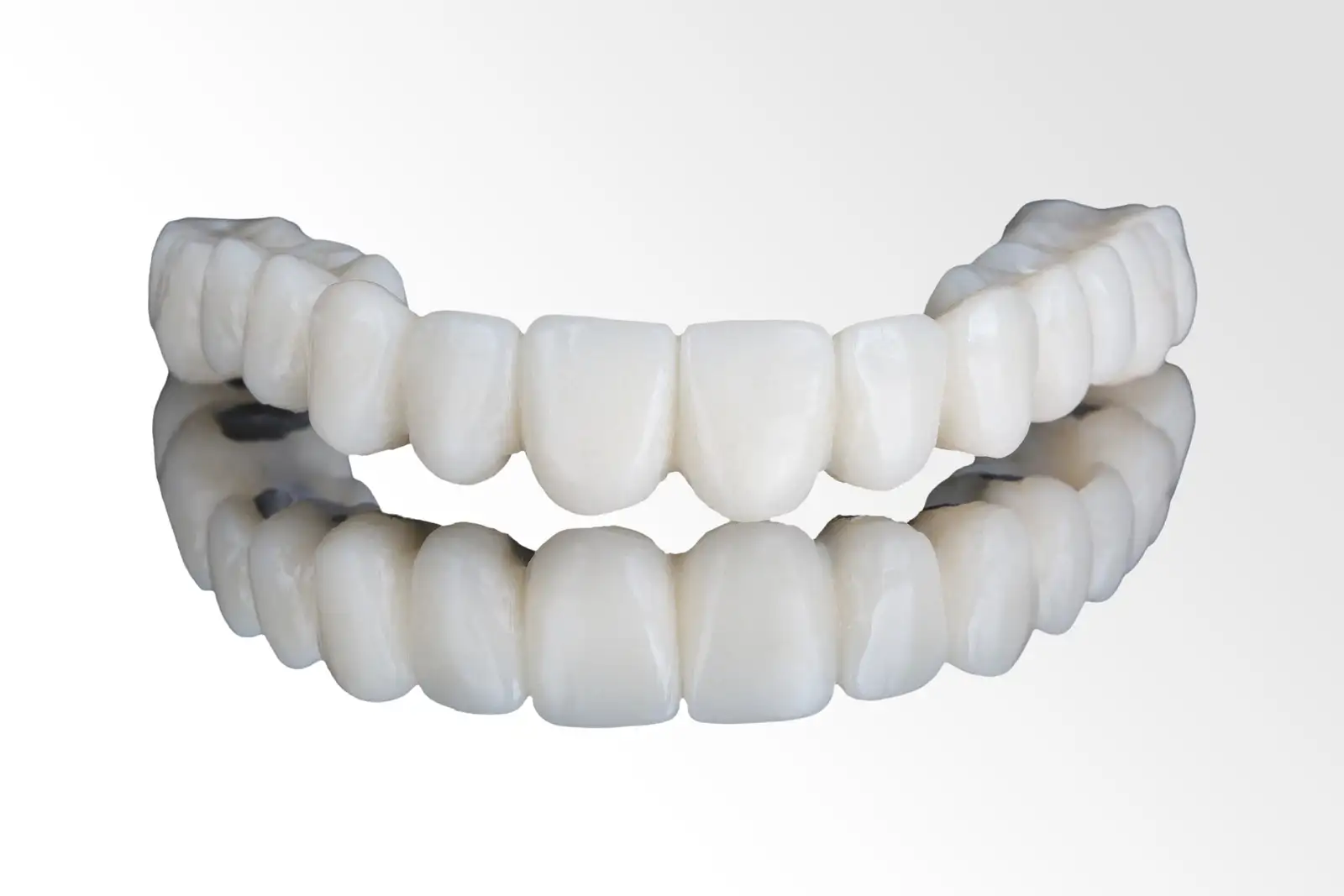Full-Arch Bridge (Circular Bridge)
If you are missing all of your teeth or if they are too damaged, you need a prosthetic dental solution that replaces all the teeth in the upper or lower jaw, relying on natural teeth or implants

A full-arch bridge provides stability and a natural appearance, offering patients an effective, long-lasting solution, security, and an improved quality of life.
What is a full-arch (circular) bridge?
A full-arch bridge is a fixed prosthetic solution used to restore all teeth in one jaw.
It is designed as an arch of 10 to 12 connected crowns, fixed onto previously prepared natural teeth (for patients with enough healthy teeth) or onto implants (in cases of complete edentulism) that serve as supports.
Thanks to modern materials such as ceramic, zirconia, or metal-ceramic, a full-arch bridge ensures a natural look, strength, and stability, allowing patients to chew and speak comfortably.
Advantages of a full-arch bridge
- Long-lasting and stable solution for replacing all teeth in a jaw
- Provides a natural-looking smile with top-level aesthetics
- Offers strength and security while chewing and speaking
- Prevents jawbone loss and preserves the natural facial structure
- Fixed solution — no fear of movement or dislodgement of the bridge
Who are candidates for a full-arch bridge?
A full-arch bridge is ideal for patients who:
- Have severely damaged or worn teeth that cannot be saved
- Have a completely edentulous jaw but prefer a fixed solution over a removable denture
- Have healthy remaining teeth that can serve as bridge supports
- Are seeking a long-lasting and stable solution with a natural tooth appearance
- Want maximum comfort and functionality, similar to natural teeth
For the successful placement of a full-arch bridge, it is essential that the remaining teeth or implants are strong enough to bear the bridge’s load.
How does the full-arch bridge placement process work?
Placement of a full-arch bridge involves several stages to ensure optimal functionality and aesthetics.
1. First visit – Examination and therapy planning
- Clinical examination and analysis of oral health
- X-ray or 3D CBCT diagnostics to assess the condition of teeth and bone
- Selection of materials and planning of the fixed solution
2. Second visit – Preparation of bridge supports
- If relying on natural teeth, they are reshaped to allow for the placement of crowns
- If relying on implants, implants are placed, and a healing period is needed for osseointegration (bonding of implants to the bone)
Taking precise impressions and making a temporary bridge
- Accurate jaw impressions are taken to craft a custom-made full-arch bridge
- Patients may receive a temporary bridge to maintain functionality while the permanent one is being made
3. Third visit – Fabrication and placement of the permanent bridge
- The bridge is fabricated from ceramic, zirconia, or metal-ceramic, depending on the patient’s needs and preferences
- The bridge is permanently cemented or screw-retained onto the implants
- Functionality, aesthetics, and comfort are checked
A full-arch bridge on implants represents a modern dental solution and a highly effective method for complete dental reconstruction, ensuring stability, functionality, and long-term aesthetics.
Thanks to precise craftsmanship and biocompatible materials such as zirconia-ceramic or titanium-ceramic, and optimal force distribution, this prosthetic work provides patients with a natural feeling, a secure bite, and high durability, making it an ideal choice for permanent full-mouth rehabilitation.
Frequently asked questions about full-arch bridges
The process can take from several weeks to several months, depending on whether implant placement is required or if it is fixed onto natural teeth.
No, the procedure is performed under local anesthesia, and any post-procedure discomfort is minimal and temporary.
Ceramic, zirconia, and metal-ceramic are most commonly used, depending on the patient’s aesthetic and functional needs.
With proper care and regular dental check-ups, a bridge can last 15–20 years or longer.
Regular brushing, the use of interdental brushes and mouthwash, and routine dental visits are necessary.
Yes, a full-arch bridge allows normal eating without restrictions, although extremely hard foods should be avoided.
A full-arch bridge can rely on natural teeth or implants, while All-on-4 and All-on-6 are fully implant-supported solutions.
The cost varies depending on the number of teeth, materials used, and whether it is supported by natural teeth or implants.
If the bridge is supported by natural teeth, a damaged support tooth may require treatment or replacement.
A full-arch bridge on implants provides a permanent, stable, and aesthetically superior solution compared to traditional dentures. Thanks to its fixed construction, it ensures a natural feeling, a firm bite, and high wear resistance.
Contact us
Our friendly team will be happy to listen to your requests.
